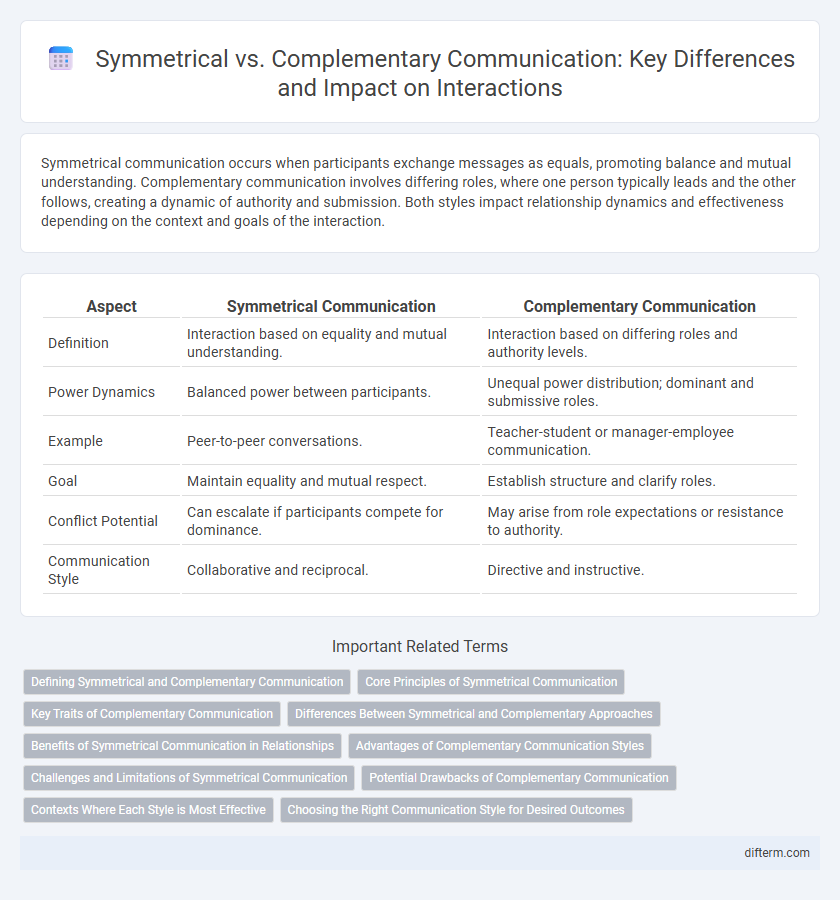Symmetrical communication occurs when participants exchange messages as equals, promoting balance and mutual understanding. Complementary communication involves differing roles, where one person typically leads and the other follows, creating a dynamic of authority and submission. Both styles impact relationship dynamics and effectiveness depending on the context and goals of the interaction.
Table of Comparison
| Aspect | Symmetrical Communication | Complementary Communication |
|---|---|---|
| Definition | Interaction based on equality and mutual understanding. | Interaction based on differing roles and authority levels. |
| Power Dynamics | Balanced power between participants. | Unequal power distribution; dominant and submissive roles. |
| Example | Peer-to-peer conversations. | Teacher-student or manager-employee communication. |
| Goal | Maintain equality and mutual respect. | Establish structure and clarify roles. |
| Conflict Potential | Can escalate if participants compete for dominance. | May arise from role expectations or resistance to authority. |
| Communication Style | Collaborative and reciprocal. | Directive and instructive. |
Defining Symmetrical and Complementary Communication
Symmetrical communication occurs when both parties engage as equals, mirroring each other's behavior and maintaining balanced power dynamics. Complementary communication involves interactions where one person assumes a dominant role while the other adopts a submissive position, creating a clear hierarchy. Understanding these patterns enhances interpersonal communication effectiveness by aligning expectations and responses.
Core Principles of Symmetrical Communication
Symmetrical communication emphasizes equality and mutual respect between participants, fostering balanced interactions where both parties share similar levels of influence and power. Core principles include openness, responsiveness, and collaboration to achieve mutual understanding and shared meaning. This communication style promotes trust and reduces conflict by encouraging reciprocal exchange and active listening.
Key Traits of Complementary Communication
Complementary communication is characterized by distinct roles where one person typically leads while the other follows, creating a clear hierarchical dynamic. This form of interaction often involves power differences, with one party holding authority and the other displaying submission or support. Key traits include predictability, role clarity, and the reinforcement of established social or professional structures.
Differences Between Symmetrical and Complementary Approaches
Symmetrical communication involves equal power and mutual understanding between participants, promoting collaboration and balance in interactions. Complementary communication is characterized by differences in power or status, where one party often takes a dominant role and the other a submissive role, creating an imbalance. These fundamental distinctions affect conflict resolution, relationship dynamics, and the effectiveness of message exchange.
Benefits of Symmetrical Communication in Relationships
Symmetrical communication fosters mutual understanding and equality, promoting trust and collaboration between partners. This balanced exchange reduces conflicts by encouraging open dialogue and empathy, leading to stronger emotional connections. Relationships benefit from increased satisfaction and resilience due to the shared responsibility and active participation in communication.
Advantages of Complementary Communication Styles
Complementary communication styles enhance clarity by establishing clear roles, reducing misunderstandings in hierarchical or mentor-mentee interactions. This style fosters efficiency as each participant contributes distinct perspectives and expertise, streamlining decision-making processes. Complementary communication also builds trust by reinforcing respect and acknowledging individual strengths, which strengthens collaboration and relationship stability in professional and personal settings.
Challenges and Limitations of Symmetrical Communication
Symmetrical communication often faces challenges such as maintaining equal power dynamics and ensuring mutual understanding, which can lead to conflicts when participants have differing perspectives or communication styles. The limitation of symmetrical communication lies in its assumption that both parties possess equal skills and willingness to engage, potentially resulting in misunderstandings or stalemates when this balance is absent. Power imbalances and emotional factors may disrupt the ideal reciprocity, highlighting the need for adaptive communication strategies to overcome these obstacles.
Potential Drawbacks of Complementary Communication
Complementary communication often creates power imbalances where one party consistently dominates decision-making, potentially leading to resentment or decreased collaboration. This dynamic can stifle open dialogue and reduce mutual understanding, as the less dominant partner may feel undervalued or silenced. Over time, complementary communication patterns risk reinforcing dependency and limiting the growth of authentic, reciprocal relationships.
Contexts Where Each Style is Most Effective
Symmetrical communication thrives in contexts requiring equality and mutual understanding, such as collaborative teamwork and peer discussions, fostering open and balanced exchanges. Complementary communication excels in hierarchical settings like management-employees interactions and teacher-student relationships, where clear roles and guidance enhance effectiveness. Choosing the appropriate style depends on the context's power dynamics and the desired outcome of the interaction.
Choosing the Right Communication Style for Desired Outcomes
Symmetrical communication fosters equality and mutual understanding, promoting collaboration and conflict resolution by encouraging open feedback and shared decision-making. Complementary communication establishes clear roles and hierarchy, enhancing efficiency in structured environments where directive guidance is necessary. Selecting the right communication style depends on desired outcomes: use symmetrical approaches for teamwork and innovation, while complementary styles suit authoritative settings requiring clarity and order.
symmetrical vs complementary Infographic

 difterm.com
difterm.com